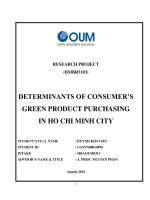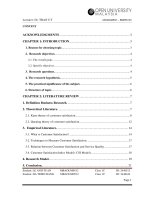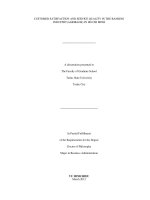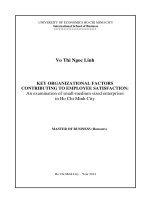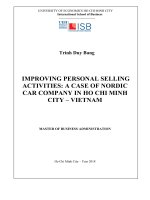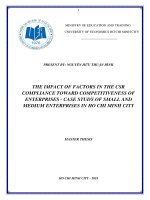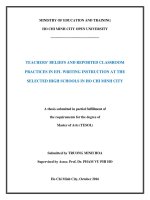Improving customer satisfaction for packeged of the duc phat company in ho chi minh city
Bạn đang xem bản rút gọn của tài liệu. Xem và tải ngay bản đầy đủ của tài liệu tại đây (1.6 MB, 45 trang )
Lecturer: Dr. TRAN UT ASSIGNMENT – BMBR5103
Student: LE ANH TUAN MBAOUM0512 Class 1C ID: 2448512
Student: HA TRIEN BANG MBAOUM0512 Class 1C ID: 2448444
Page1
CONTENT
ACKNOWLEDGMENTS 3
CHAPTER 1: INTRODUCTION 3
1. Reason for choosing topic 3
2. Research objectives. 4
2.1. The overall goals. 4
2.2. Specific objectives 4
3. Research questions 4
4. The research hypothesis 5
5. The practical significance of the subject. 6
6. Structure of topic 6
CHAPTER 2: LITERATURE REVIEW 7
1. Definition Business Research 7
2. Theoretical Literature. 7
2.1. Kano theory of customer satisfaction 8
2.2. Queuing theory of customer satisfaction 12
3. Empirical Literature 14
3.1. What is Customer Satisfaction? 14
3.2. Techniques to Measure Customer Satisfaction 17
3.3. Relation between Customer Satisfaction and Service Quality 17
3.4. Customer Satisfaction Index Model ( CSI Model) 18
4. Research Model 19
5. Conclusion 21
Lecturer: Dr. TRAN UT ASSIGNMENT – BMBR5103
Student: LE ANH TUAN MBAOUM0512 Class 1C ID: 2448512
Student: HA TRIEN BANG MBAOUM0512 Class 1C ID: 2448444
Page2
CHAPTER 3: RESEARCH METHODOLOGY 22
1. Research Framework 22
2. Research Process 23
3. Study Design. 24
3.1. Qualitative Methods 24
3.2. Quantitative Methods 24
3.3. Scale construction. 28
4. Methods of data analysis . 30
CHAPTER 4: RESEARCH RESULTS AND DISCUSSION 33
1. Research results 33
1.1. Sample characteristics 33
1.2. Scale testing 33
2. Conclusion 42
CHAPTER 5: SUMMARY, CONCLUSION AND RECOMMENDATIONS43
1. Summary 43
2. Conclusion 43
3. Recommendation 44
References 45
Lecturer: Dr. TRAN UT ASSIGNMENT – BMBR5103
Student: LE ANH TUAN MBAOUM0512 Class 1C ID: 2448512
Student: HA TRIEN BANG MBAOUM0512 Class 1C ID: 2448444
Page3
ACKNOWLEDGMENTS
First and foremost, we would like to thank us lecture Tran Ut, her continued support and
mentorship throughout program. Her encouragement has been invaluable throughout this entire
process.
CHAPTER 1: INTRODUCTION
1. Reason for choosing topic.
Today, the competitive environment is becoming increasingly fierce, the wisdom of the enterprise
is to bring higher customer satisfaction than the competitors in the same industry, because the
satisfaction of customer proportional to the profits of the business which brings the success of
business with customer loyalty to their brand. In the business strategy of the company always
toward to customer and considered the most important strategy, this has made international brands
such as Samsung, Nike, etc. So how to understand and responded to customer needs satisfied, that
is the difficult question, and is the secret of each company, and tool in the competitive
environment. And DUC PHAT is the same, since its establishment and development constantly
trying to give the best customer satisfaction with all abilities. Accordingly, DUC PHAT has always
in the customer loyalty. Be researching and improving for customer satisfaction has always been
maintained and developed by DUC PHAT.
With the above reason I chose topic ” IMPROVING CUSTOMER SATISFACTION FOR
PACKAGED OF THE DUC PHAT COMPANY IN HO CHI MINH CITY “ to research on
the subject Business Research Method.
Lecturer: Dr. TRAN UT ASSIGNMENT – BMBR5103
Student: LE ANH TUAN MBAOUM0512 Class 1C ID: 2448512
Student: HA TRIEN BANG MBAOUM0512 Class 1C ID: 2448444
Page4
2. Research objectives.
2.1. The overall goals.
This study was conducted with the purpose of evaluating customer satisfaction of Birthday Cake
packaged of DUC PHAT company in HCM city; based on which give out a number of solutions to
help companies and managers can summarize the experiences to further enhance product quality in
order to improve customer satisfaction to the demands and competitive environment of the society.
2.2. Specific objectives.
To achieve the overall objective mentioned above, research should focus on the following specific
objectives:
Identify factors about product affecting customer satisfaction.
Measure the impact of these factors about product to customer satisfaction.
Find out the differences may have on the level of customer satisfaction for product
between customer groups by characteristics such as: gender, age, educational level,
etc…
Proposed some solutions to improve customer satisfaction for Birthday Cake packed of
DUC PHAT’s company.
3. Research questions.
To achieve the research objectives, questions to gather information that will focus on the following
main contents:
Lecturer: Dr. TRAN UT ASSIGNMENT – BMBR5103
Student: LE ANH TUAN MBAOUM0512 Class 1C ID: 2448512
Student: HA TRIEN BANG MBAOUM0512 Class 1C ID: 2448444
Page5
What are quality factors to affect customer satisfaction for DUCPHAT’s packaged?
How does the impact of product quality factors to the satisfaction of the customers?
Is there a difference in the level of customer satisfaction for product between customer
groups by characteristics?
From this study, work out how to improve our product to meet our customer needs?
4. The research hypothesis.
As product quality, price, packaging and label play an important role and affect customer
satisfaction in their purchase process. A hypothesis about the relationship between the quality of
training and the satisfaction of participants is set out as follows:
H1: Product quality includes factors that create good quality products. The higher product
quality as satisfied customer with consumer products, Hypothesis is: there is a relationship
same way between product quality and customer satisfaction.
H2: The price is important, indispensable in commodity trading. The price is a tool to
increase competitive advantage, low price will make customers happy, and the hypothesis
is the assumption that the same way between price and customer satisfaction.
H3: Packaging is a very important factor in the purchasing activities. Customers will not be
happy or accept poor quality packaging, not in accordance with the requirements of the
product. Hypothesis would be: is there a relationship in the same direction packaging and
customer satisfaction.
H4: Brands play an equally important role in creating quality products for the organization.
Brand has long years…, which will create customer confidence. So, the higher the brand,
customer more satisfied with the purchase of that product. Since then, the hypothesis is set:
there is the same relationship between the brand and customer satisfaction.
Lecturer: Dr. TRAN UT ASSIGNMENT – BMBR5103
Student: LE ANH TUAN MBAOUM0512 Class 1C ID: 2448512
Student: HA TRIEN BANG MBAOUM0512 Class 1C ID: 2448444
Page6
5. The practical significance of the subject.
The practical significance of the subject will be the core base to give benefits for the following
subjects:
Company can improve, further improve product quality to customer satisfaction;
Research results can help managers have a holistic view of product quality, as a basis to
help build orientation, policies and improve product quality better, satisfy customer
requirements and society.
6. Structure of topic.
Chapter 1: Introduction
Chapter 2: Literature Review
Chapter 3: Research Methodology
Chapter 4: Research Result and Discussion
Chapter 5: Summary, Conclusion and Recommendation
Lecturer: Dr. TRAN UT ASSIGNMENT – BMBR5103
Student: LE ANH TUAN MBAOUM0512 Class 1C ID: 2448512
Student: HA TRIEN BANG MBAOUM0512 Class 1C ID: 2448444
Page7
CHAPTER 2: LITERATURE REVIEW
1. Definition Business Research.
A systematic inquiry aimed at providing information to solve problem [Cooper and Emory (1995)
defined research]
Research is the process of systematically gathering and analyzing information in order to gain
knowledge and understanding [Kevin (1992) in his book entitled “Methods for Business
Research” stated]
An organized, systematic, databases, critical, objective, scientific inquiry or investigation into a
specific problem [Sekaran (2003) defined]
A systematic and objective process of gathering, recording and analyzing data for aid in making
decision [Zikmund (2003) defined Business Research]
In a business context, research is defined as an organized and systematic process of investigation to
address a specific business problem or issue
To research for this literature review, we have 2 part included theories and empirical researches
that are relevant for understanding the customer satisfaction:
2. Theoretical Literature.
The research of theories about customer satisfaction will have three theories in the time sequence.
It will be indicated clearly by Kano theory and Queuing theory that will be introduced in this
section. Every theory has different outlook and the following’s detail of each theory:
Lecturer: Dr. TRAN UT ASSIGNMENT – BMBR5103
Student: LE ANH TUAN MBAOUM0512 Class 1C ID: 2448512
Student: HA TRIEN BANG MBAOUM0512 Class 1C ID: 2448444
Page8
2.1. Kano theory of customer satisfaction.
The Kano model is a theory of product development and customer satisfaction developed in the
80s by Professor Kano . The author indicated that customer needs are never changing, this means
with following example: As a customer who purchased a lot of music, their needs were simple. The
customer only wanted clearer sound and something smaller to store. The music industry responded
and introduced the cassette. The cassette was indeed smaller. It did not fade out and then back in
with that annoying “click” that my 6-track tapes used to have. The customer was pleased with their
cassette collection. And then with no long time, the music industry introduced something called a
CD – a compact disc. The CD offered better clarity, more storage capacity and the ability to jump
to specific songs, or shuffle the order of their play. Best of all, one never had to rewind!
Through that as a customer, their needs changed. In the move to CDs, they did not realize their
needs had changed but the music industry, through research, keeping up with the competition and
advances in technology, delighted me with new product offerings. Even today as my CDs are dust
covered because I only utilize my iPod, new advances in music technology are being made to
further address music customer needs.
According to Kano is that customer satisfaction is proportional to the extent to which the product or
service is fully functional. Based on that he give the model with three types of requirements the
following:
Satisfying basic needs: Allows a company to get into the market.
Satisfying performance needs: Allows a company to remain in the market.
Satisfying excitement needs: Allows a company to excel, to world class.
Lecturer: Dr. TRAN UT ASSIGNMENT – BMBR5103
Student: LE ANH TUAN MBAOUM0512 Class 1C ID: 2448512
Student: HA TRIEN BANG MBAOUM0512 Class 1C ID: 2448444
Page9
Figure 2.1: Kano Model.
For satisfying basic needs:
This model is the same Maslow’s needs theory to obtain high satisfaction is first to have to obtain
basic satisfaction with needs. One of the main points of assessment in the Kano model is the
threshold attributes. These are basically the features that the product must have in order to meet
customer demands. If this attribute is overlooked, the product is completely incomplete. If a new
product is not examined using the threshold aspects, it may not be possible to enter the market.
This is the first and most important characteristic of the Kano model. The product is being
manufactured for some type of consumer base, and therefore this must be a crucial part of product
innovation. Threshold attributes are simple components to a product. However, if they are not
available, the product will soon leave the market due to dissatisfaction. The attribute is either there
or not. An example of a threshold attribute would be a steering wheel in a vehicle. The vehicle is
no good if it is not able to be steered.
Lecturer: Dr. TRAN UT ASSIGNMENT – BMBR5103
Student: LE ANH TUAN MBAOUM0512 Class 1C ID: 2448512
Student: HA TRIEN BANG MBAOUM0512 Class 1C ID: 2448444
Page10
These needs are typically “unspoken.” If these needs are not fulfilled, the customer will be
extremely dissatisfied. This includes a clean bathroom, clean linens and a pleasant in the air. When
we book a reservation at a hotel, we do not request a clean room but this implies our expected
about it. If this basic need is not met, we will be extremely dissatisfied.
The same Maslow's needs theory to achieve safe needs must first achieve physiological needs and
this is too. When achieving this satisfaction is to continue Satisfying performance needs to remain
in the market for a company. Kano’s theory for this problem is that if a product or service wants
into market is first thing which have to satisfy customer’s basic needs.
For Satisfying performance needs:
These needs are different from the basic needs, performance needs are typically “spoken”, and this
means that customer needs are expressed. Kano confirmed for this problem that if a company has a
high-performance attributes will have a competitive advantage which compare to competitors
because performance attributes are those for which more is generally better, and will improve
customer satisfaction. Using the hotel example again, “spoken” needs could be Internet access, a
room away from the elevators, a non-smoking room, etc.
Conversely, an absent or weak performance attribute reduces customer satisfaction. The price a
customer is willing to pay for a product is closely tied to performance attributes. So the higher the
performance attribute, the higher the customers will be willing to pay for the product. Performance
needs are slogan of each firm which also their business strategy for product or service toward. For
example computer needs, although laptop is more expensive than other normal computer but with
its characteristics can bring everywhere so, customer is willing to buy with it this. And with Coop-
Lecturer: Dr. TRAN UT ASSIGNMENT – BMBR5103
Student: LE ANH TUAN MBAOUM0512 Class 1C ID: 2448512
Student: HA TRIEN BANG MBAOUM0512 Class 1C ID: 2448444
Page11
Mart slogan is friends of all family and with Satisfying performance needs are right price. So,
companies must always find out customer’s performance needs.
This is only condition to a firm remain in the market and to allows a company to excel, to be world
class are that company must satisfy excitement needs of customer that showed the finally type of
requirement of Kano.
For satisfying excitement needs of customer:
This excitement needs are also typically “unspoken” and unexpected by customers but it bring
result in high levels of customer satisfaction, however their absence does not lead to dissatisfaction.
Excitement attributes often satisfy latent needs – real needs of which customers are currently
unaware. Using the hotel example again, “unspoken and unexpected” are that we stay a hotel who
delighted by a freshly baked, chocolate chip cookie delivered to their room during turn-down
service, all aren’t expected and required by customer. In a competitive marketplace where
manufacturers’ products provide similar performance, providing excitement attributes that address
“unknown needs” can provide a competitive advantage. Although they have followed the typical
evolution to a performance then a threshold attribute, cup holders were initially excitement
attributes.
Finally, we can see that out of all the attributes introduced in the Kano Model, the excitement ones
are the most powerful and have the potential to lead to the highest gross profit margins. Innovation
is undisputedly the catalyst in delivering these attributes to customers; we need to be able to
distinguish what is an excitement today, because tomorrow it becomes a known feature and the day
after it is used throughout the whole world.
Lecturer: Dr. TRAN UT ASSIGNMENT – BMBR5103
Student: LE ANH TUAN MBAOUM0512 Class 1C ID: 2448512
Student: HA TRIEN BANG MBAOUM0512 Class 1C ID: 2448444
Page12
2.2. Queuing theory of customer satisfaction.
In customer satisfaction, each theory will have a different opinion of each author. Similarly with
Kano’s customer satisfaction theory is to have Queuing theory which discusses also the effecting
factors to satisfaction. The Queuing theory indicates that Speed (waiting) of service has been
shown to provide businesses a competitive advantage in the marketplace, it means clearly that the
primary issue in queuing management and customer satisfaction is not the actual amount of time a
customer waits for service, but the customer’s perception about that wait and the associated level of
satisfaction. A highly satisfied customer will be very likely to provide repeat business and spread
the positive experience by word of mouth (advertising), resulting in increased revenues and
profitability. Example: I just arrived at my local pharmacy to get a new prescription filled and to
pick up a few other things. There is a line of five people at the register and another six people
sitting in the waiting area. By the time I get to the counter to hand the cashier my prescription, 10
minutes have passed. I ask how long the wait will be and I am told 35 to 40 minutes. I go about my
shopping and return to the pharmacy 30 minutes later. Again, there are people in line at the register
and it takes me another 8 minutes to find out that my prescription is not ready. Feeling weary and
somewhat frustrated, I have a seat in the waiting area. As I sit there, I watch people come and
people go. At last my name is called! I pay the cashier and my pharmacy encounter is complete.
However, I don’t feel good about it, and from that times, I did not come there any more, “a
customer has left”.
Conversely, an unsatisfied customer will most likely not provide repeat business and will be more
than willing to share his or her bad experience with whoever will listen. This will have an obvious
negative impact on profits and revenues. We feel weary, un-pleasure as waiting a long time for
product or service (delivery…).
Lecturer: Dr. TRAN UT ASSIGNMENT – BMBR5103
Student: LE ANH TUAN MBAOUM0512 Class 1C ID: 2448512
Student: HA TRIEN BANG MBAOUM0512 Class 1C ID: 2448444
Page13
We can see that the measurement of customer satisfaction as it relates to waiting time is highly
qualitative and subjective, and the relationship is generally inversed in nature (in general, as
waiting time decreases, satisfaction increases). This relationship was further expanded by Master
who, in 1985, postulated that satisfaction is dependent on customer perception and customer
expectation. For example, one study examined customer attitudes toward waiting times in the hotel
and restaurant industry and found that over 70% of all respondents were clearly concerned about
waiting times. In fact, those most concerned about waiting times were generally more willing to
pay more to avoid waiting in line and believed that quality is worth waiting for. The results of this
survey indicate that queues do affect the satisfaction level of customers and their willingness to
spend. In addition, this study also suggests that there is a point where a lengthy wait begins to
affect the customer’s perception of quality. The main goal of queuing management is to maximize
the level of customer satisfaction with the service provided
In fact today, this theory is increasingly widespread application, especially for the company
business about services (bank ). At this point, we can conclude with this theory is that in order to
increase customer satisfaction, the company not only meets the demand for the products they need,
but also in the quality of service for the wait. Any company brings to high customer satisfaction
which customer loyalty will also be high. Satisfaction and customer loyalty is proportional to each
other. All are illustrated with specific examples.
Through the two showed theory above, we can understand that there are factors effected customer
satisfaction which each firm should find out to satisfy their.
Lecturer: Dr. TRAN UT ASSIGNMENT – BMBR5103
Student: LE ANH TUAN MBAOUM0512 Class 1C ID: 2448512
Student: HA TRIEN BANG MBAOUM0512 Class 1C ID: 2448444
Page14
3. Empirical Literature.
In this section will give us an overview of what the customer satisfaction is, Techniques to Measure
Customer Satisfaction, relation between customer satisfaction and service quality, Customer
Satisfaction Index Mode.
3.1. What is Customer Satisfaction?
The customer satisfaction becomes an important asset for businesses and organizations in an effort
to improve the quality of the service, to maintain loyalty, enhance the competitiveness of
enterprises. In 1989, the index of measuring the level of satisfaction was first launched in Sweden
(Swedish Customer Satisfaction barometer - SCSB) was established customer satisfaction index for
the purchase and consumption of products and services domestic service. And in the following
years, this index was developed and widely applied in developed countries like America - ACSI,
Norway - NCSI, Denmark - DCSI and EU countries - ECSI (1998). This index can be done on the
national level (enterprise, how the industry will meet for their customers) or internal angle sector
(compare the satisfaction of the business in within a sector) and a comparison between the different
times (to see the change). Since then, the business can know its position, the customer reviews for
businesses to plan the business goals and strategies. So to understand what customer satisfaction is,
we will have many various outlook to the concept of satisfaction by everyone, the following is
detailed outlook:
There are two principal interpretations of satisfaction as a process and satisfaction as an outcome
(Parker and Mathews, 2001). Early concepts of satisfaction research have typically defined
satisfaction as a post choice evaluative judgment concerning a specific purchase decision [Oliver,
1980; Churchill and Suprenant (1992). Bearden, William O. and Teel (1983); Oliver and DeSarbo
Lecturer: Dr. TRAN UT ASSIGNMENT – BMBR5103
Student: LE ANH TUAN MBAOUM0512 Class 1C ID: 2448512
Student: HA TRIEN BANG MBAOUM0512 Class 1C ID: 2448444
Page15
(1988). But Swan and Combs (1976) were among the first to argue that satisfaction is associated
with performance that fulfils expectations, while dissatisfaction occurs when performance falls
below expectations. In addition, Poisz and Von Grumbkow (1988) view satisfaction as a
discrepancy between the observed and the desired. This is consistent with value - percept disparity
theory (Westbrook and Reilly,1983) which was developed in response to the problem that
consumers could be satisfied by aspects for which expectations never existed (Yi,1990). The value
- percept theory views satisfaction as an emotional response trigged by a cognitive - evaluative
process (Parker and Mathews, 2001). In other words, it is the comparison of the "Object" to one's
values rather than an expectation.
Besides that, we can understand customer satisfaction with other opinion: Customers want a
meeting between their values (needs and wants) and the object of their evaluations (Paker and
Mathews, 2001). More recently, renewed attention has been focused on the nature of satisfaction:
emotion, fulfillment and state (Parker and Mathews, 2001). Consequently, recent literature adds to
this perspective in two ways. First, although traditional models implicitly assume that customer
satisfaction is essentially the result of cognitive processes, new conceptual developments suggest
that affective processes may also contribute substantially to the explanation and prediction of
consumer satisfaction [Fornell and Wernerfelt (1988), Westbrook (1987), Wesbrook and Oliver
(1991)]. Second, satisfaction should be viewed as a judgment based on the cumulative experience
made with a certain product or service rather than a transaction - specific phenomenon (Wilton and
Nicisia, 1986).
There is general agreement that: Satisfaction is a person’s feelings of pleasure or disappointment
resulting from comparing a product’s perceived performance (or outcome) in relation to his or her
expectations ( Kotler,2003. p.36). Based on this review, customer satisfaction is defined as the
Lecturer: Dr. TRAN UT ASSIGNMENT – BMBR5103
Student: LE ANH TUAN MBAOUM0512 Class 1C ID: 2448512
Student: HA TRIEN BANG MBAOUM0512 Class 1C ID: 2448444
Page16
result of a cognitive and affective evaluation, where some comparison standard is compared to the
actually perceived performance. If the perceived performance exceeds expectation, customers will
be satisfied. Otherwise, if the perceived expectations are met with performance, customers are in an
indifferent or neutral stage.
Customer satisfaction is defined as a customer’s overall evaluation of the performance of an
offering to date. This overall satisfaction has a strong positive effect on customer loyalty intentions
across a wide range of product and service categories (Gustafsson, 2005).
The satisfaction judgment is related to all the experiences made with a certain business concerning
its given products, the sale process, and the after-sale service. Whether the customer is satisfied
after purchase also depends on the offer’s performance in relation to the customer’s expectation.
Customers form their expectation from past buying experience, friends’ and associates’ advice, and
marketers’ and competitors’ information and promises (Kotler, 2000).
Factors which determine the extent of expectations are: customer needs, total customer value and
total customer cost. It is mentioned by researchers who study customer choice that choosing a
product or service is only one of the stages customers go through. A purchase decision is
influenced by the buyer’s characteristics. These include cultural, social, personal and psychological
factors. In addition to the buyer’s characteristics, a purchase decision is influenced by the buyer’s
decision process. The typical buying process develops through five stages: 1 new recognition; 2
information search; 3 information evaluation; 4 purchase decision and 5 post-purchase evaluation
(Chaston, 2001).
Searching for information is a key stage of a customer’s decision-making process and may include
a search for both internal and external information. As the perceived risk of a purchase decision
Lecturer: Dr. TRAN UT ASSIGNMENT – BMBR5103
Student: LE ANH TUAN MBAOUM0512 Class 1C ID: 2448512
Student: HA TRIEN BANG MBAOUM0512 Class 1C ID: 2448444
Page17
increases, consumers search for more information in order to cope with uncertainties about the
potential positive or negative consequences (Jihye Park, 2005).
3.2. Techniques to Measure Customer Satisfaction.
To measure customer satisfaction in market research will have 4 different techniques, it is the
following:
Customer satisfaction survey methodologies;
Focus group to study customer satisfaction issues;
Standardized packages for monitoring customer satisfaction and
Various computer software
But there are some problems with typical customer satisfaction measurement techniques such as
focus groups, survey methodologies and customer satisfaction software. These include:
Analytical- concerned with techniques, formal procedures, systems, and so on;
Behavioral – concerned with the attitudes, beliefs, perceptions, motivation, commitment
and resulting behavior of the people involved in the process ; and;
Organizational – concerned with the Organizational structure, information flows,
management style and corporate culture, i.e. the context in which the process is conducted
(Piercy, 1996).
3.3. Relation between Customer Satisfaction and Service Quality.
The business is often said that the service quality is customer satisfaction. However, many studies
show that customer satisfaction and service quality are two distinct concepts but have close
relationship with each other. Quality of service is the concept of objectivity, the nature of price and
Lecturer: Dr. TRAN UT ASSIGNMENT – BMBR5103
Student: LE ANH TUAN MBAOUM0512 Class 1C ID: 2448512
Student: HA TRIEN BANG MBAOUM0512 Class 1C ID: 2448444
Page18
perception, while satisfaction is a combination of the subjective component, based on feelings and
emotions (Shemwell & CTG, 1998, Thongsamak, 2001).
3.4. Customer Satisfaction Index Model ( CSI Model).
For this customer satisfaction model will have 2 models which are completely different for
satisfaction, but every model has the various advantages and disadvantage, the following is detail:
Firstly, American Satisfaction Index (ACSI), perceived value is influenced by the perceived quality
and customer expectations. Meanwhile, customer expectations have a direct impact on perceived
quality. In fact, when the expectation is higher can feel the quality standards of the customers for
the product or vice versa. Therefore, the requirements for product quality and service provided to
customers must ensure and be satisfied on the basis of their satisfaction. Customer satisfaction is
formed on the basis of perceived quality, expectations and perceived value, if the quality and
perceived value higher expectations will create customer loyalty, otherwise, there is a complaint or
complaints about consumer products that they (as Figure 2.1).
Figure 2.1: The Model of American Customer Satisfaction Index – ACSI.
Perceived
value
Customer
Satisfaction
Complaint
Expectations
Perceived quality
Loyalty
Lecturer: Dr. TRAN UT ASSIGNMENT – BMBR5103
Student: LE ANH TUAN MBAOUM0512 Class 1C ID: 2448512
Student: HA TRIEN BANG MBAOUM0512 Class 1C ID: 2448444
Page19
Following that, Model of European Satisfaction Index (ECSI) is a certain difference. Compared
with ACSI, photos of the product, the brand has a direct impact on the expectations of our
customers. Meanwhile, customer satisfaction is the impact Synchronization of 4 factors photos,
perceived value, and perceived quality of both tangible and intangible products. Typically, only of
ACSI is often applied to the field of application also ECSI indicators usually measure products, the
industry (Figure 2.2).
Figure 2.2: The Model of European Satisfaction Index – ECSI.
4. Research Model.
On the basis of the theory and the results of previous studies are concerned, the author inherited the
SERVQUAL scale by Parasuraman (2005), and edited five elements: means tangible, reliable,
responsive, make security and empathy into 4 elements: product quality, price, packaging and
Perceived
value
Customer
Satisfaction
Perceved quality-Prod
Perceved quality–Service
Loyalty
Image
Expectations
Lecturer: Dr. TRAN UT ASSIGNMENT – BMBR5103
Student: LE ANH TUAN MBAOUM0512 Class 1C ID: 2448512
Student: HA TRIEN BANG MBAOUM0512 Class 1C ID: 2448444
Page20
brand to measure and evaluate customer satisfaction of products in inner HCM city. Specifically,
the elements of the quality scale were modified from the SERVQUAL scale as followings:
(1) The product quality can be adjusted from the elements inside to ensure food safety, raw
material for making cakes, soft cake
(2) Prices are shown a willingness to pay of customer to purchase, the comparison between what
the product is worth to pay. The lower the price the higher the competitive advantage.
(3) Packaging is shown impressive product image in the minds of consumer.
(4) Packaging is one of the elements that make up customer confidence with the product. Good
brand is also to affect the purchase decision.
Research on the relationship between product and customer satisfaction, thought to rotate around
the 4 main axis (component / or subject area) reflect the new/full resolution target that the subject
has posed. These four elements have a close and intimate relationship to measure quantify the
satisfaction of the customer to buy their packed.
The proposed research model to assess, measure customer satisfaction of packaged Birthday
Cake on HCM city area through 4 elements: product quality, price, packaging and brand as
follows:
Lecturer: Dr. TRAN UT ASSIGNMENT – BMBR5103
Student: LE ANH TUAN MBAOUM0512 Class 1C ID: 2448512
Student: HA TRIEN BANG MBAOUM0512 Class 1C ID: 2448444
Page21
H1
H2
H3
H4
Figure 2.3: Proposed Research Model.
5. Conclusion.
This chapter presents a summary of the theory and research related to customer satisfaction,
product quality, the relationship between product and customer satisfaction. On the basis of
theory and related research, the author inherited and discovered from the study of the
SERVQUAL scale by Parasurama (2005) and other same study include 4 components: product
quality, price, packing and brand with purpose towards the analysis, as well as components for the
measurement of customer satisfaction are using, have used and will use packaged Birthday Cake
in inner HCM city.
Product quality
Price
Packaging
Brand
Customer
Satisfaction
Lecturer: Dr. TRAN UT ASSIGNMENT – BMBR5103
Student: LE ANH TUAN MBAOUM0512 Class 1C ID: 2448512
Student: HA TRIEN BANG MBAOUM0512 Class 1C ID: 2448444
Page22
CHAPTER 3: RESEARCH METHODOLOGY
1. Research Framework .
Figure 3.1: Framework of research on the relationship between product quality and customer
satisfaction (Source: General Studies).
Issues/ Problems
The competition between companies in the same industry
Requirements, product requirements of the customer are increasing.
Lack of management and supervision of the company, especially the
government agencies, for business functions packaged bread in the place
of sale
The quality of products exist many shortcomings: running after profits,
sales
Interventions
Improved product quality: investment in machinery and equipment,
production line, good quality raw material, product development
research…
Expanding markets: connect multiple intermediaries wholesale & retail
Needed supervision, management and measurement of product quality in
the sales of the government’s products, local authorities
The competition between companies
Expected Outputs
Meet the needs of customers
Products attract customers
Building a professional sales team
Outcomes Customer
Satisfaction
Lecturer: Dr. TRAN UT ASSIGNMENT – BMBR5103
Student: LE ANH TUAN MBAOUM0512 Class 1C ID: 2448512
Student: HA TRIEN BANG MBAOUM0512 Class 1C ID: 2448444
Page23
2. Research Process.
Figure 3.2: Research Process (Source: General Studies).
Research objectives
Theoretical basis
Practical research
Research models / theories
Quantitative Methods
Qualitative Methods
Results / reports
Lecturer: Dr. TRAN UT ASSIGNMENT – BMBR5103
Student: LE ANH TUAN MBAOUM0512 Class 1C ID: 2448512
Student: HA TRIEN BANG MBAOUM0512 Class 1C ID: 2448444
Page24
3. Study Design.
To ensure scientific research is conducted through two main stages: (1) research to develop
interview; (2) quantitative research to collect and analyze survey data, testing the model.
Specifically, the two phases are presented in the following sections:
3.1. Qualitative Methods.
The objective of the research phase detect the factors that affect customer satisfaction, to adjust
the scale to match specific quality products at the places of sale Birthday Cake packaging in Ho
Chi minh City area. The results of the research in order to identify the components of product
quality affect customer satisfaction. And on that basis, to discuss and determine the scale for each
factor, build a preliminary interview questions.
3.2. Quantitative Methods.
After completing the preliminary questionnaire, a pilot study was done to ensure that the question
is appropriate and the question is understood by most people. 10 preliminary questions for 10
clients are using Birthday Cake packed on the inner city, then discuss directly with each
customers to see if they can easily understand each question, and completed a formal
questionnaire for extensive interviews.
The study was officially implemented by the method of quantitative research, customer interviews
directly on area Ho Chi Minh City.
3.2.1. Determining the sample size.
With known overall unit (N = 721 824) - according to the statistics bureau and DUC PHAT
company, so the sample size is calculated by the formula Slovin:
Lecturer: Dr. TRAN UT ASSIGNMENT – BMBR5103
Student: LE ANH TUAN MBAOUM0512 Class 1C ID: 2448512
Student: HA TRIEN BANG MBAOUM0512 Class 1C ID: 2448444
Page25
In which:
n = sample size
N = overall unit
e = error of number (% that be permitted)
We have:
N = 721.824 (customers)
Choosing = 4.50% (about tolerance e <10%)
n =
From the above calculation results, the survey sample size will be 494 (customers).
3.2.2. Distribution of sample.
According to survey data from the General Statistics Office as of 1/4/2011, the city's population is
7,549,341 people. Therefore, the research is done by dividing the target population into urban /
rural districts (stratified sample) and randomly selected individuals in the stratification. This way
to ensure total customer allocation spread / spread across the counties / districts. Specifically,
stratified sample shall comply with the following criteria:
Stratification of the target population is urban / rural districts;
The determination of sample size is a way of taking statistical significance, but sometimes
this process is ignored by choosing appropriate sample size ratio accuracy. However, if
you choose the sample size is too large or larger than the minimum level is expensive and

